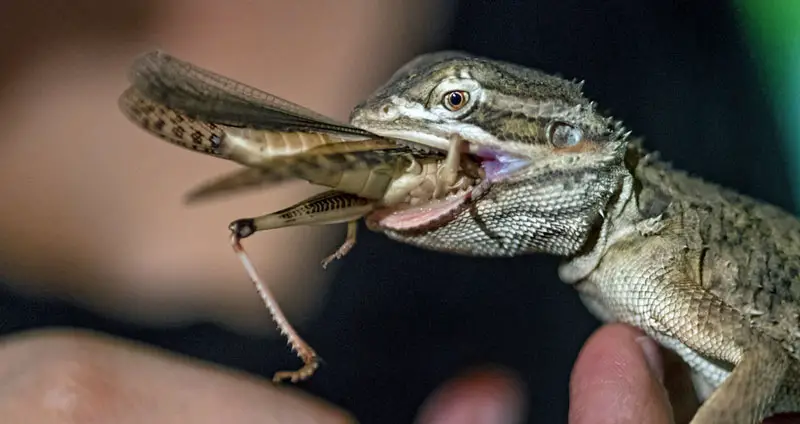Grasshoppers are found on every single continent except for Antarctica. These widespread insects come in all shapes, sizes, and colors and live in a variety of different habitats.
With all of the different habitats of grasshoppers, they’re bound to have different behaviors, diets, and predators.
What exactly eats these creepy-looking insects? Are grasshoppers’ predators the same throughout the world, or do they differ by region?
Table of Contents
What Eats Grasshoppers?
Many different animals eat grasshoppers, with birds, mammals, other insects, reptiles, amphibians, fish, and even fungi feeding on these insects.
The specific type of animal that eats grasshoppers depends on the region that they’re in. Specifically, what predators live there and what other food sources exist.
So, quite a few different animals eat grasshoppers. Let’s take a closer look at a grasshopper’s predators.
1. Birds
Birds are easily one of the main predators of grasshoppers. Many different species of bird eat grasshoppers, and these species differ between countries.
Bluebirds are one of the most notorious grasshopper-eating birds, as they’re widely praised for their pest control abilities.
Other predatory birds include blackbirds, blue jays, hawks, chickens, and turkeys.
Birds are able to find these grasshoppers both while they’re out and about and while they’re hiding in grass — so they’re never quite safe.
2. Mammals
Mammals are also a large consumer of grasshoppers, and this includes mammals of all shapes and sizes.
Raccoons are a very common grasshopper predator, as are opossums, brown bats, red foxes, and least shrews.
Small rodents also thrive off of grasshoppers. In fact, there’s a mouse called the northern grasshopper mouse that feeds primarily off of, you guessed it, grasshoppers.
3. Reptiles
In the wild, reptiles like snakes, lizards, and turtles regularly feast on grasshoppers. In fact, even in captivity reptiles’ diets are often complimented by frequent grasshoppers.
Reptile owners love to feed grasshoppers to their reptiles, with bearded dragons being the most common eater. They’re very large, nutritious, and easy to find, which makes it a perfect feeder insect.
Breeding grasshoppers is also quite simple, making it easy to maintain a constant supply.
4. Amphibians / Fish
American toads and other amphibians actively hunt down grasshoppers as they commonly share habitats.
Surprisingly, fish also eat grasshoppers! This happens when the grasshopper gets too close to a lake’s/pond’s edge and puts it within reach of a fish like a largemouth bass.
5. Insects
While grasshoppers are insects themselves, they also fall prey to other insects. One of the most common insect predators of grasshoppers is the praying mantis.
Other insects that eat grasshoppers are garden centipedes, wasps, beetles, rabid wolf spiders, crickets, large ants, and dragonflies.
Some of these insects hunt and kill grasshoppers, while others simply wait for one to die and then eat it.
6. Fungi
Believe it or not, fungi is a killer and eater of grasshoppers!
Specificially, the type of fungi called Entomophthora grylli affects grasshoppers when they climb on plants that are infexted with the fungus.
When infected, the grasshopper is forced to wrap around the plant and stays there until it dies. The fungus then spreads throughout its body and forms spores that become airborne and infect other plants/grasshoppers.
How Do Grasshoppers Defend Themselves?
With hundreds of different animals feeding on grasshoppers, these insects have needed to develop ways to protect/defend themselves against potential predators.
How do grasshoppers defend themselves, then? Grasshoppers don’t bite, so how else do they stay alive?
- Jumping away – Using their massive, strong legs, grasshoppers are often able to jump far away from predators. Even if they’re being held in place, they can use their legs to push themselves away.
- Flying away – Most species of grasshoppers have wings and can just fly away from predators. They aren’t extremely good fliers, but they’re able to fly far enough to keep themselves safe.
- Poison – A few species of grasshoppers are aposematic, meaning that they’re poisonous and have bright colors that warn predators. This has proven to be successful in detering predators.
- Spitting – Grasshoppers are able to spit up a brown liquid nicknamed “tobacco juice” when threatened. This liquid is made up of food and digestive enzymes and tastes terrible. It’s not very effective as a deterrent, but it’s better than nothing.

